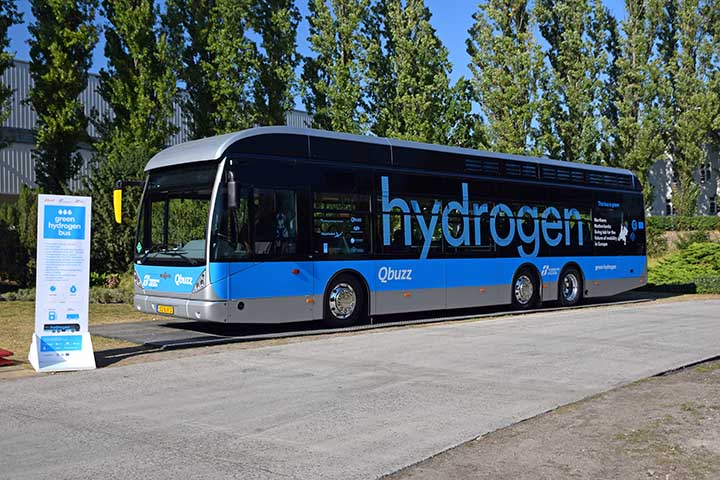The Hydrogen Rainbow: Elected Officials Focus on Green
The post The Hydrogen Rainbow: Elected Officials Focus on Green appeared first on POWER Magazine.

Blue, green, turquoise, yellow, pink, blue, grey and brown/black. Hydrogen is currently beset by a host of colorful adjectives, but what part of the hydrogen rainbow is most likely to lead to a pot of gold (and environmental benefits)? Elected officials across the country are more and more focused on promoting green hydrogen, which is increasingly viewed around the world as a no-carbon fuel that can play a critical role to reduce greenhouse gas emissions.
Discovered more than 250 years ago, hydrogen has a long history as a fuel. The first internal combustion engine, designed by Francois Isaac de Rivaz in 1806, ran on hydrogen, and the hydrogen fuel cell was also developed in the 19th century. Today more than 20,000 forklifts powered by fuel cells are operating across the U.S. However, the vast majority of the 10 million metric tons of hydrogen produced in the U.S. last year was used in industrial applications, such as oil refining and chemical manufacturing.
COMMENTARY
Why does a colorless gas implicate a painter's palette of colors? Simply put, each color represents a different method of producing hydrogen. Grey hydrogen is the most common today and is produced from natural gas through steam methane reforming. Coal gasification can produce brown (or black) hydrogen. Capture and sequester the carbon dioxide emitted from producing grey hydrogen, and that grey hydrogen becomes blue. Methane pyrolysis produces turquoise hydrogen and solid carbon. Green hydrogen is produced using renewable power and electrolysis with other colors derived from the same process, but using different sources of electricity.
 Eric L. Martin
Eric L. MartinGreen hydrogen has a number of useful energy and environmental attributes. For example, with renewable power as the key feedstock, it can be generated when supply outstrips demand and used to store" renewable power for later use, much like a battery. However, unlike battery storage, energy stored as hydrogen does not degrade over time. Hydrogen can also be stored in a variety of forms with greater energy density on both a mass and volume basis, as compared to a lithium-ion battery.
In fact, hydrogen has an energy density (120MJ/kg) on a mass basis almost three times more than gasoline or diesel (45MJ/kg), which facilitates transportation uses. Using hydrogen as a fuel does not result in carbon dioxide emissions. Green hydrogen can be blended, with certain constraints, with natural gas, thereby creating an opportunity to reduce the carbon intensity of many existing uses of natural gas, such as residential heating.
 Kelly A. Echols
Kelly A. EcholsOf course, there are always competing factors that deserve consideration. For example, as hydrogen and methane have different physical and chemical properties, the transportation and use of hydrogen in existing natural gas infrastructure and equipment warrants detailed evaluation. The energy density of hydrogen on a volume basis is lower than that of gasoline or diesel. For vehicles to achieve the same range as possible with gasoline or diesel, the vehicles typically need redesign or modification to accommodate larger fuel storage compartments. In addition, water is a feedstock of renewable hydrogen, which could influence deployment in water-scarce areas. That said, the amount of water needed to produce renewable hydrogen is relatively small.
Around the country elected officials are introducing bills and passing new laws to encourage the production and use of green hydrogen. As with many energy policies, the California state government has been active. The enactment of California SB 1369 in 2018 called for state government to consider hydrogen produced by electrolysis as a form of energy storage that could meet the state's clean energy goals.
The following year, Oregon enacted SB 98, creating a statutory framework for utilities to invest in renewable natural gas," which was defined to include green hydrogen, and the state's largest natural gas utility is now working to develop a green hydrogen production facility. Similar bills were introduced in Minnesota (SF 421) and Colorado (SB 21-161) this year. The Washington legislature in 2019 enacted a statute (Sub. SB 5588) authorizing public utility districts to generate renewable hydrogen," which was defined to include green hydrogen, and to sell it in containers for use in manufacturing.
Construction began earlier this month on a 5-MW electrolyzer adjacent to a hydroelectric dam on the Columbia River. The Montana legislature is currently considering a bill (HB 170) that would modify property taxes for facilities that produce green hydrogen to facilitate the development of a $1-billion green hydrogen plant in Butte, Montana, which would store the hydrogen in underground salt caverns in Utah until needed to generate power.
On the federal level, President Biden's recently announced American Jobs Plan calls for pairing an investment in 15 decarbonized hydrogen demonstration projects ... with a new production tax credit," and investing $15 billion in climate change-related demonstration projects, including hydrogen.
Of course, not all legislative efforts to promote hydrogen in recent years have been focused on green hydrogen. For example, in 2017 Utah enacted a credit against state severance taxes on natural gas, if the gas is used in Utah to produce hydrogen for use in zero-emissions motor vehicles. And the December 2020 federal COVID stimulus bill promoted blue hydrogen by extending the deadline for commencing construction of carbon capture and sequestration projects eligible for Section 45Q tax credits by two years, to the end of 2025. In addition, hydrogen-fueled vehicles are eligible for various state and federal incentives, regardless of the type of hydrogen used to fuel such vehicles.
The legislative efforts to date promoting the production and use of green hydrogen, although still somewhat nascent, are likely to grow, particularly as the resulting projects come to fruition and economic and environmental benefits are realized. Spurring investment and growth are perennial legislative goals, and when combined with addressing climate change, green hydrogen may well lead to the end of the rainbow.
-Eric L. Martin is a partner with Stoel Rives, focused on natural resource development. Kelly A. Echols is a partner with Stoel Rives and an experienced chemical patent attorney.
The post The Hydrogen Rainbow: Elected Officials Focus on Green appeared first on POWER Magazine.